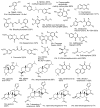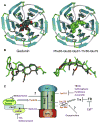Development of Neh2-luciferase reporter and its application for high throughput screening and real-time monitoring of Nrf2 activators
- PMID: 21700211
- PMCID: PMC3251032
- DOI: 10.1016/j.chembiol.2011.03.013
Development of Neh2-luciferase reporter and its application for high throughput screening and real-time monitoring of Nrf2 activators
Abstract
The NF-E2-related factor 2 (Nrf2) is a key transcriptional regulator of antioxidant defense and detoxification. To directly monitor stabilization of Nrf2, we fused its Neh2 domain, responsible for the interaction with its nucleocytoplasmic regulator, Keap1, to firefly luciferase (Neh2-luciferase). We show that Neh2 domain is sufficient for recognition, ubiquitination, and proteasomal degradation of Neh2-luciferase fusion protein. The Neh2-luc reporter system allows direct monitoring of the adaptive response to redox stress and classification of drugs based on the time course of reporter activation. The reporter was used to screen the Spectrum library of 2000 biologically active compounds to identify activators of Nrf2. The most robust and yet nontoxic Nrf2 activators found--nordihydroguaiaretic acid, fisetin, and gedunin--induced astrocyte-dependent neuroprotection from oxidative stress via an Nrf2-dependent mechanism.
Copyright © 2011 Elsevier Ltd. All rights reserved.
Figures







References
-
- Calabrese V, Cornelius C, Mancuso C, Pennisi G, Calafato S, Bellia F, Bates TE, Giuffrida Stella AM, Schapira T, Dinkova Kostova DT, Rizzarelli E. Cellular stress response: a novel target for chemoprevention and nutritional neuroprotection in aging, neurodegenerative disorders and longevity. Neurochem Res. 2008;33:2444–2471. - PubMed
-
- Carrier RL, Ma TC, Obrietan K, Hoyt KR. A sensitive and selective assay of neuronal degeneration in cell culture. J Neurosci Methods. 2006;154:239–244. - PubMed
Publication types
MeSH terms
Substances
Grants and funding
LinkOut - more resources
Full Text Sources
Other Literature Sources

